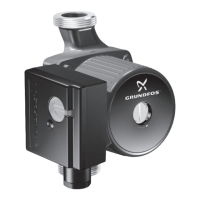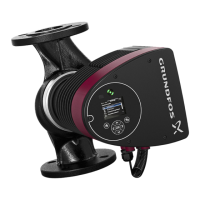5.9 Vibration damping
5.9.1 Elimination of noise and vibrations
In order to achieve optimum operation and minimum noise and
vibration, consider vibration damping of the pump. Generally,
always consider this for pumps with motors of 15 hp (11 kW) and
up. Vibration damping is mandatory for motors of 125 hp (90 kW)
and up. Smaller motor sizes, however, may also cause undesirable
noise and vibration.
Noise and vibration are generated by the revolutions of the motor
and pump and by the flow in pipes and fittings. The effect on the
environment is subjective and depends on correct installation and
the state of the rest of the system.
Elimination of noise and vibrations is best achieved by means of a
concrete foundation, vibration dampers and expansion joints. See
the figure below.
••
••• •••• •••• •••• •••• •••• ••••• •••• •••• •••• •••• •••• •••• •••• •••• •••• ••••• •••• •••• •••• •••• •••• •••• •••• •••• •••• ••••• •••• •••• •••• •••• • ••• •••• •••• •••• •••• •••• ••••• •••• ••••
TM085937
5.9.2 Vibration dampers
To prevent the transmission of vibrations to buildings, we
recommend that you isolate the pump foundation from building
parts by means of vibration dampers. This decision must be made
by the customer or designer or consultant of the installation.
The selection of the right vibration damper requires the following
data:
• forces transmitted through the damper
• motor speed, taking speed control, if any, into consideration
• required damping in % - suggested value is 70 %.
The selection of vibration damper will differ from installation to
installation. In certain cases, a wrong damper may increase the
vibration level. Vibration dampers must therefore be sized by the
supplier of the vibration dampers.
If you install the pump on a foundation with vibration dampers,
always fit expansion joints on the pump flanges. This is important to
prevent the pump from "hanging" in the flanges.
5.10 Expansion joints
Expansion joints provide these advantages:
• absorption of thermal expansion and contraction of pipes
caused by variations in liquid temperature
• reduction of mechanical influences in connection with pressure
surges in the pipes
• isolation of structure-borne noise in the pipes, applying only to
rubber bellows expansion joints.
Do not install expansion joints to make up for inaccuracies
in the pipes, such as center displacement or misalignment
of flanges.
The expansion joints must be fitted at a minimum distance of 1 to
1.5 times of the pipe diameter away from the pump on the inlet and
the outlet side. This will prevent turbulence in the expansion joints,
thus ensuring optimum inlet conditions and minimum pressure loss
on the outlet side. At flow velocities greater than 16.4 ft/s (5 m/s),
we recommend that you fit larger expansion joints matching the
pipes.
The figures below show examples of rubber bellows expansion
joints with or without limiting rods.
TM024979
Rubber bellows expansion joint with limiting rods
TM024981
Rubber bellows expansion joint without limiting rods
We always recommend that you use expansion joints with limiting
rods for flanges larger than 4 inches in order to reduce the effects of
the expansion or contraction forces on the pipes.
Follow the supplier’s instructions and pass them on to advisers or
pipe installers.
You must anchor the pipes in such a way that they do not stress the
expansion joints and the pump.
The figure below shows an example of a metal bellows expansion
joint with limiting rods.
TM024980
Metal bellows expansion joint with limiting rods
Due to the risk of rupture of the rubber bellows, we recommend that
you use metal bellows expansion joints at temperatures above 212
°F (100 °C) combined with high pressure.
20
English (US)

